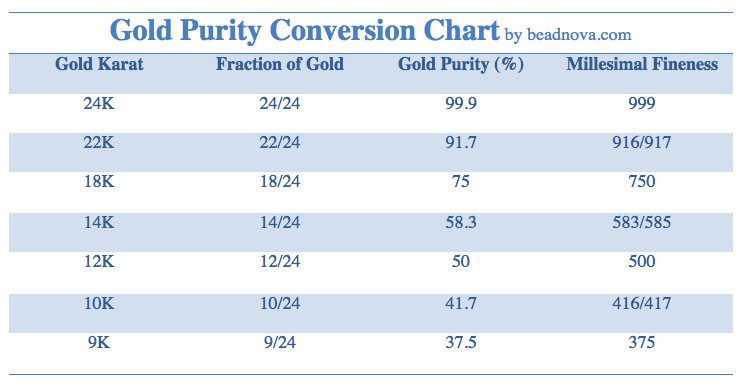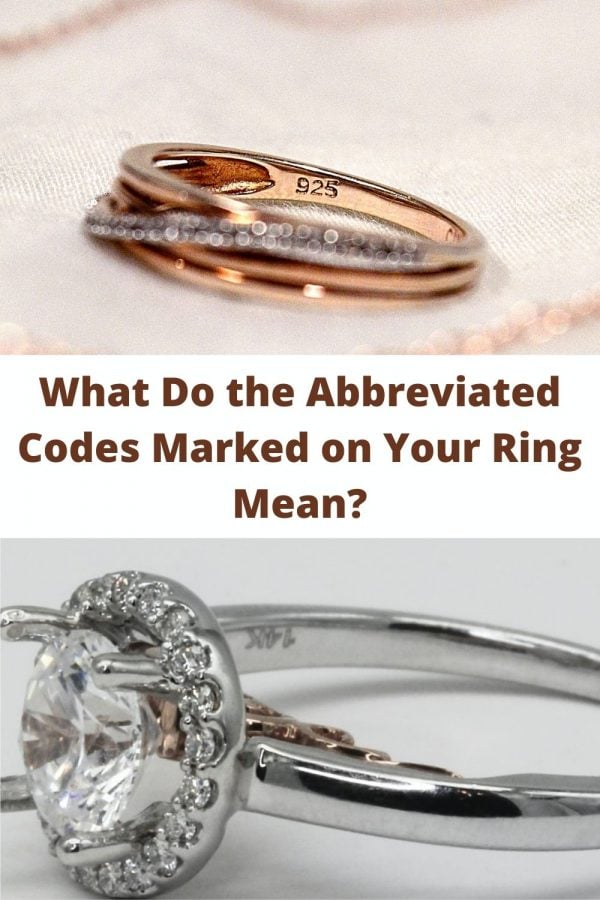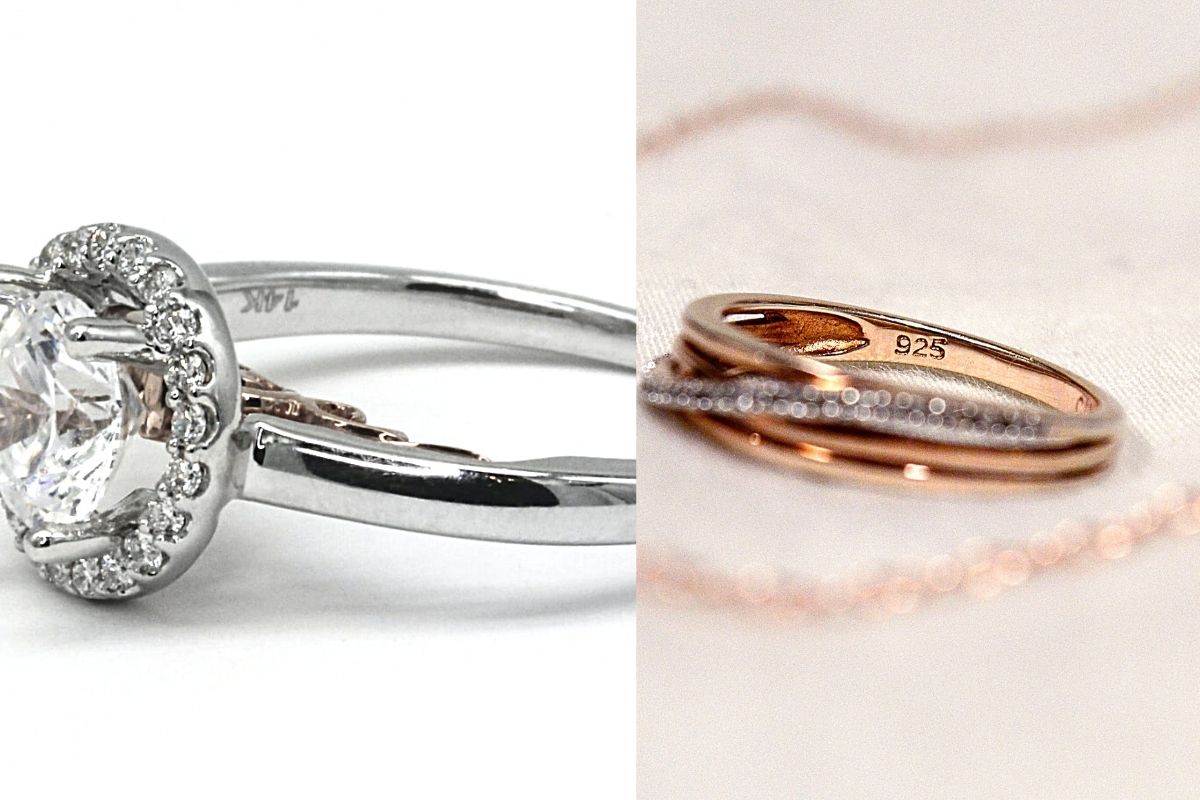Have you ever been curious about the mark stamps inside the ring? Ring hallmarks are a standard part of professionally-made jewelry and purity marks, especially for more expensive metals like karat gold.
Table of Contents
Material and Purity Marks
The most common marks found in rings are the purity marks, often denoted by a numerical value or a combination of a numerical value plus a letter.
For Gold Jewelry
Purity marks for gold jewelry are simple to read because they represent the karat weight of the precious metal. 9k is nine karats (for the United Kingdom market), 10k is ten karats (this is often yellow gold or white gold), 12k is twelve karats (more common in global markets rather than in the U.S.), 14k is 14 karats, up to 24k (24 karats of yellow gold).
Some variations make use of the decimal value of the weight – for ten karats, we have .417, fourteen karats is .585, eighteen karats is .750, twenty karats are .833, and a .999 stamp of purity denotes pure gold (24 karats). WGD refers to the weight of gold.

Of course, not all jewelry is made of gold, and there are also other precious metals to consider.
For Platinum Jewelry
Platinum jewelry should have P.T. or PLAT. Jewelry stamped with 950 or 900 is also made of platinum, not silver or gold.
For Stainless Steel Jewelry
The S.S. or S.S. stamps denote that the jewelry has been manufactured from stainless steel. The same applies to logos like St. Steel and Steel.
For Sterling Silver Jewelry
What about silver? Silver rings will usually be stamped with self-explanatory marks like Sterling Silver, S. Silver, Silver, or just plain Silver. A 925 symbol can also denote sterling silver. Should you see a .950 mark, that’s silver, not platinum. The additional period clears the air of any confusion.
Further reading: Sterling Silver vs 925 Silver vs Pure Silver- Are They The Same?
Others Jewelry
The G.E. mark indicates that the jewelry is not made primarily of gold but another metal and has only been electroplated with gold. The G.P. mark is also identical to G.E. The ring size mark may also be stamped on the inside of rings depending on the preference of the manufacturer.
Jewelers’ or Designers’ Hallmarks
Government regulations require jewelry manufacturers and manufacturers of acceptable dining items to stamp designer’s hallmarks onto their products. These hallmarks are critical for establishing the value of jewelry and silverware, for example.
There would be no way to grade antique jewelry if there are no true hallmarks properly. The hallmarks also indicate the flexibility and durability of jewelry and reveal the actual metal used in the fabrication. The four most common metals used for jewelry are platinum, palladium, gold, and silver.
All genuine or fine jewelry must contain a certain percentage of a high-value metal. The quantity added by the manufacturer must be stamped somewhere inconspicuous, so the owner can evaluate these hallmarks later when the need arises.
It is not possible to tell the purity of a piece of jewelry by simply looking at it. Many modifying metals that were merely looking at a piece of jewelry won’t indicate the innocence of a tall. That’s why it’s essential to look at the metal stamps to check for purity before buying new jewelry.
There are compulsory hallmarks that must always be marked onto jewelry.
Sponsor Mark
The first stamp is the sponsor mark or markers mark. This metal stamp represents the company that is registered in making jewelry from precious metals. Manufacturers must have their own definite and identifiable characters, so it’s more practical to look at the stamps to identify the actual jewelry maker.
Purity Mark
The next mark is the purity mark or the millesimal fineness symbol. These represent the type of metal and how much of the precious metal is added to the jewelry. The weight of gold is denoted either by ct or K. In the U.K.; it is more common to see the ct mark. Palladium jewelry, on the other hand, will have either a 950 mark or 500.
Hallmark
Next on our list is the hallmark representing the assay office. Assay offices are responsible for the hallmarking of fine jewelry and testing for fineness. Each of the four U.K. assay offices has one has a unique stamp so the jewelry can be traced.
Optional Hallmark
There are optional hallmarks as well. Option hallmarks are special symbols that indicate the year when the jewelry was first crafted. These special symbols are often small letters like r or q, and they won’t repeat over time, so there would be no confusion about the production date.
The date stamp on fine jewelry changes every first of January. Date letters are not compulsory, so don’t expect to find them in all kinds of fine jewelry, especially those made outside the U.K. or U.S. The jewelry market has always been global, so western standards are not practiced in other countries.
Some countries like the U.K. have laws like the Hallmarking Act of 1973 that require manufacturers and assay offices to stamp fine jewelry. Such laws are not always present in other countries.
What about traditional fineness marks? Standard fineness marks are symbols that have been used to denote certain special events in the originating country. In the United Kingdom, they have several essential but non-compulsory traditional marks from palladium to silver, symbolized by Lady Britannia, seated with staff and shield.
There are also essential events denoted in commemorative stamps, from the Silver Jubilee of 1935, 1953, Silver Jubilee of 1977.
As for how the hallmarking is done, there are two methods – laser engraving and metal stamping. The older method is just metal stamping because there weren’t laser engraving tools back in the day. Traditional stamps are rare nowadays because they pose a risk of damaging the delicate insides of minor jewelry.
As for laser engraving, it too comes with a disadvantage – laser engraving can be rubbed out or polished out sometimes, and without the proper hallmarks, it can be more challenging to grade or value a piece of jewelry.

More articles you may interest:
Meaning of the Marks Stamped Inside Your Jewelry
Which Is More Expensive: White Gold, Rose Gold or Yellow Gold?
How to Identify If My Jewelry is Sterling Silver?




Leave A Comment